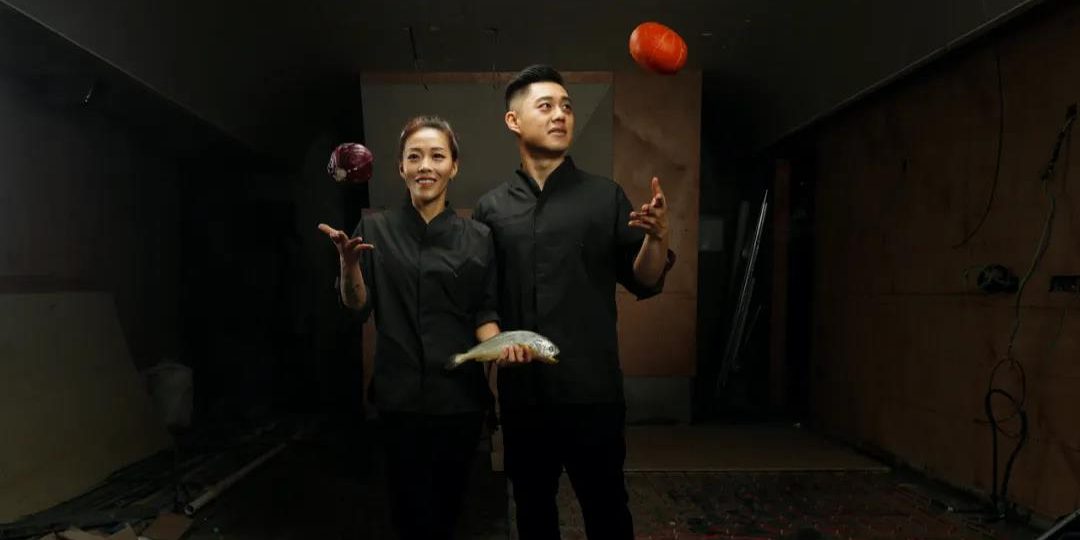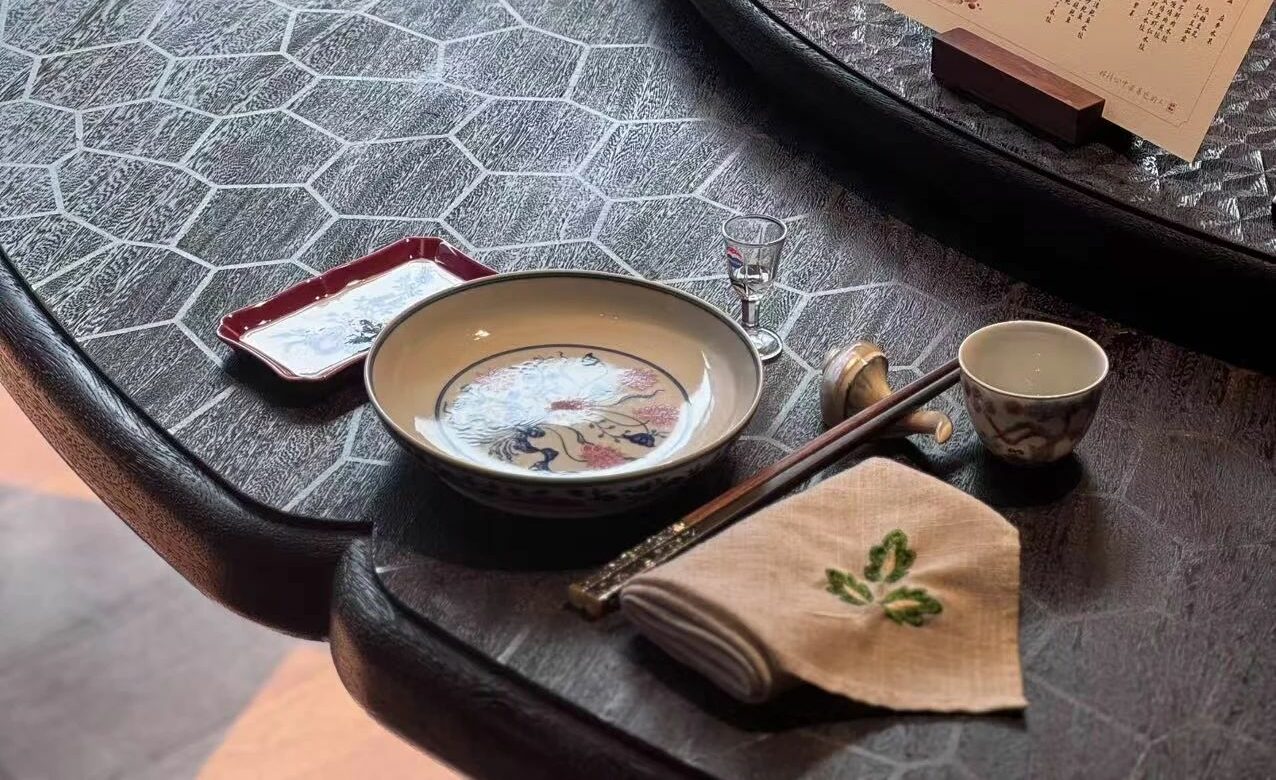Author:

Reborn
Shanghai’s only Michelin-starred female chef, DeAille Tam, and her partner (also in life) Simon Wong, after the closed Bo Shanghai two years ago, are delighted to present their brand new vision for innovative modern Chinese cuisine – Obscura. The compact and stylish restaurant is the result of their year-long research deep-diving into the delicious China. A unique blend of Chinese traditional flavours and Western cooking perspectives, Obscura is an exceptional, multisensory experience that’s set to become one of the representative destination restaurants in Shanghai.
I met DeAille and Simon at Bo Shanghai and it’s been four years now. During this time, I’ve written about them in my journal articles and tried to play with a bit of ‘cinematography’ as well. But my interests in them do have a solid rationale: Bo Shanghai got a Michelin star in the 2018 edition and that was just one year after the restaurant’s opening. Their sturdy cooking techniques have surely supported my belief in their great expectations.
Bo Shanghai ran into leasehold problem and had to close two years ago. Maybe going through things like that has changed them, I could sense the air of confidence and maturity exuded by the couple when I saw them again earlier this year. I asked DeAille what the most difficult part at that time was, and she said, it’s the restaurant staff and her brilliant team. Fortunately, when they decided to open Obscura, all staff came back, including the senior sanitation worker they used to have at the old restaurant. ‘This is a true relief,’ she said.
Intricacy
DeAille and Simon have been unbelievably good at lending sophistication and complexity to their creations since their Bo Shanghai period. Their dishes are highly complex in the variety of ingredients and the way they handle them, not loved by all but something falls within Michelin criteria. The two already are Obscura’s guarantee to the Michelin stars.
I have always considered the seats in front of an open kitchen to be the best. It turns out that this idea is not exclusive to me. My gourmet friends and other chef friends feel the same with me. I would think that a compact restaurant with limited seating suits DeAille and Simon’s style more.


As if on cue, Obscura is everything it’s supposed to be. With eleven seats on the first floor and a four-meter banquet table that caters ten on the second floor, the restaurant’s enigmatic interior design echoes what lies under its name, secluded and mysterious. Walking into Obscura is a mind-soothing adventure where meditations on culinary arts and aesthetics become natural. DeAille told me that she had always wanted a small-size restaurant where she could elaborate on each detail and exchange feedback with guests.
Forgoing the rules and protocols of the great eight cuisines used to be held tight by close collaborator Alvin Leung at Bo Shanghai, DeAille describes having more freedom in the design of menus now that she owns the restaurant.
DeAille and Simon used to be heavy-handed on complexity and molecular dishes, perhaps influenced by their pedigree in French cuisine and Leung. Now they have cut down on the use of molecular dishes, exemplified by ground Dragon Well Shrimp, leaves as garnishing but main ingredients still lie in the heart of everything.
Innovative Modern Chinese Cuisine
Some dishes were particularly impressive:


Lion’s Head Meatballs with Crab Roe
Made with Iberian pork jaw and Chinese mitten crab roe, the deep-fried meatball is served with Japanese sea urchin and a dab of crab-flavoured dressing made with Shaoxing yellow wine aged for 12 years. The ritual is, scrumptious mitten crabs naturally go with Chinese yellow wine. Now the dish has combined two into one. The slightly salty lion’s head was purposefully balanced with the sweetness of sea urchin. I love the umami explosion of yellow wine and crab roe, and the meaty lion’s head served just about right to mediate oceanic overlaps from crab roe and sea urchin.
Taste of Sichuan
The dish specifically selects Kue fish from Yamaguchi Prefecture in Japan, a kind that’s available all year round but particularly fatty in winter. Only those weighing less than ten kilograms and matured for seven days are selected, allowing the fish to develop new flavours and fully absorb the seasoning. Cut into strips and each wrapped with sauerkraut powder, the fish strips are then wrapped with cling film, deep freezed and sliced again so that the result looks marbled.

Purchased as a whole, the trout roes are carefully taken out one by one and pickled with white soy sauce (produced using wheat rich in starch as main material with the addition of a little amount of soybean) to absorb its sweetness. Ribbons of lotus roots are marinated with pickled pepper vinegar to keep the taste of sauerkraut. But with redesigned taste and temperature, this dish is studded with flavour land mines to pick around — planks of pickled lotus stems, a fistful of sauerkraut powder, warm vinegar sauce prepared with sauerkraut juice, and some pickled trout roe.
Sauerkraut serves two purposes here: the powder to wrap the fish, and vegetables stewed to a clear broth mixed with a set portion of homemade green pepper oil, tingling but not overly numbing. It is incredibly good — rich, sour, hot, eye-pleasingly elegant and mind-blowingly yummy.


Dragon Well Shrimp
Also known as shrimp stir-fried with Dragon Well tea, this is a speciality of Hangzhou City, Zhejiang Province. The two chefs deploy several cooking methods in treating the Longjing green tea here, one being the use of essential tea oil extracted at tea-making temperature. Interestingly, DeAille and Simon have found that tea tasting is all about smell, and tea oil is the best wheel to offer up the slightly sweet, mellow and grassy fragrance of Longjing leaves.
The peony shrimps are immersed in tea oil for more than ten hours to allow full absorption of the tea fragrance, and Longjing tea leaves are finely grounded and sprinkled on the soft-boiled egg. Finally, a splash of spongy hijiki (a brown sea vegetable growing wild around the coasts of Japan, Korea, and China) previously soaked in tea oil and tea water is added into a beautiful bisque made with peony shrimp shells.
Traditional ways of doing Longjing Prawns are more or less monotonous in colour, texture and taste. Obscura, on the other hand, offers a comfort version with creamy textures, snow-white prawns, syrupy-centred egg and the velvety bisque.


Bao Zi
Char Siu Bao (barbecued pork buns) used to be the signature dish of Bo Innovation. It uses a spheroidization technique to fill the bun with completely liquefied char siu pork filling while retaining the classy flavour of char siu sauce.
I didn’t ask if the name of the dish has anything to do with the past, but DeAille and Simon were both Canadian Hong Kong people, so for them, Char Siu Bao is something that brings back the nostalgia of their treasured childhood memories. Obscura’s upmarket Char Siu Bao uses indulgent seafood materials (Brittany lobster, fish maw) and meigan cai (a type of dry pickled Chinese mustard of the Hakka people from Guangdong province), and garnished with gold leaves on top. DeAille said that the lobster and fish maw do not need much ado because of their robust umami flavour, so they tried to make a special sauce to mimic the taste of real pork char siu. Savoury meigan cai was added to balance the sweetness of lobster and fish maw, a creative touch with tangy notes. Adopting the method of making milk buns, paper-thin dough is crafted at best stretchiness to hold together the rich, tender, plentiful filling.
The shape of the bun has also been modified to become the more commonly-known version for Char Siu Bao. An opening on top of the satchel is allowed to achieve better baking results. I had thought that the char siu sauce would contrast and disturb the umami lobster – but it didn’t, not at all. The well though-through flavour, the luxurious ingredients, the creative classic delight… what’s not to love about it?

Taihu Three Whites
Inspired from a famous freshwater speciality when DeAille and Simon were shooting “A Private Banquet” in Anji, Zhejiang, this dish draws signature materials of the White Fish, Whitebait and White Shrimp, while also improvising with aromatic Italian Alba white truffles, slightly fried luscious Japanese Shirako (white roe of male fish) and soft-crunchy cauliflower. Together they make a complementary whole but each shines on its own.

Hunan Bacon & Pepper
A classic from Hunan province, this one is famous for its mouth-numbing peppercorns, eye-watering spices and juts-can’t-get-enough smoky bacon strips. Obscura’s rendition uses Hunan chopped peppers, pickled chilli sauce, dried radish and M9+ Australian wagyu beef, similar to Bo Shanghai’s method but with adjustments in plating styles. This is a mulled-over masterpiece with more simplicity and higher completeness.


I was even more amazed when the dessert was presented: the glutinous rice balls were wrapped in a layer of crispy fried glutinous rice, filled with mixed pine nuts and pecans, and served with a bowl of warm Eight Treasures Tea soup. Unexpectedly harmonious and full of Chinese flair.
The Petit Four finale didn’t fail me. The walnut cake is filled with Lin’an speciality walnuts and mixed with chopped dried persimmons. The unassuming mung bean cake uses Sicilian pistachio and mung bean paste, garnering overlaps of nutty and earthy notes but jazzing up the flavour to compose a jolly surprise.
Perfect Duet
DeAille and Simon make an interesting pair, and the whole co-head chef concept reminds me of Sühring, Obscura’s sister restaurant in Bangkok. DeAille described crafting each dish with Simon, all original pieces of the two, not some inner soliloquy.


Their culinary works are sophisticated, yet with infusions of delicacy and tenderness. Aesthetic is getting increasingly important for professional chefs, but still, their cooking is not obvious to define. DeAille herself described their style to be like Obscura, mysterious, untouchable and hard to draw lines. It may take some time to actually comprehend, and that is in other words saying, they do put emphasis on complexity.
Even with western-inspired Chinese fusion cuisine taking on popular tides, DeAille and Simon employ western cooking basics, but the mainstay is still Chinese cuisine. When Obscura becomes an interesting spot for the city’s postcards, I believe they would have the ability to deconstruct enormous Chinese culinary treasures into tasty gems which can be appreciated by diners all over the world.
It is a shame that blue cheese is increasingly known by China’s younger generations, whereas most westerners have never heard of stinky tofu. Was it because we used to be so arrogant that we didn’t care to publicize our time-honoured culinary treasures?
DeAille spoke of better grasping the palate of Chinese diners and having that market cornered. And they are confident to offer even more. I am not going to say their dishes are ten out of ten, but I can give at least seven, which means one Michelin star if I were the judge. DeAille and Simon are a few steps towards their peak, and I have full faith in them to achieve that.
The menu is a smooth run through the dozen course set. Hiroyuki Kanda, a Tokyo three-starred master chef once said, display cooking (cooking in front of guests) evokes the tense between the cook and the guest. It creates intrigue and invites the guest to investigate. Now Obscura is in the game. With only 11 seats and opening 5 days a week, my guess is that it would become one of the most difficult to book restaurants in Shanghai in the second quarter. Bookings through Wechat mini program are open on the first and fifteenth days every month.
Decency and dignity are what everybody wants in a career, and being a cook is no exception. We all like cooking for people who genuinely understand what we want to express through the dishes. Now, make sure to stay hungry and make a dash for Obscura’s next seasonal menu when you can.

Would you believe this:
Things we lose have a way of coming back to us in the end, if not always in the way we expect.
Photos of the environment are provided by Obscura

Reprint or other cooperation matters
Please contact WeChat account:tastytrip2020
Welcome to follow us
Weibo:TastyTrip
Instagram:_tastytrip_










